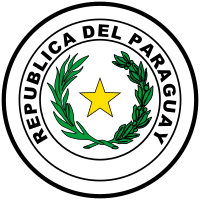Transport in Paraguay
Paraguay's transportation system ranges from adequate to poor, largely depending on the region of the country. The country has a network of roads, railroads, rivers, and airports, but significant infrastructure and regulation improvements are needed.[1]
Roads in Paraguay
Estimates vary on the total extent of Paraguay's road system, from more than 60,000 kilometres (37,000 mi) to less than 30,000 kilometres (19,000 mi). The discrepancies seem to be the result of differing standards regarding what constitutes a road. Thousands of kilometers of unpaved rural roads exist. Paraguay has about 15,000 kilometres (9,300 mi) of paved, major feeder roads. The core network connects Asunción, Encarnación, and Ciudad del Este. The Trans-Chaco highway is only partially finished, the paved portion ending at Mariscal Estigarribia. Bolivia's portion of the highway, in contrast, is entirely paved. For trade purposes, the paved highways from Ciudad del Este to the Brazilian port of Paranaguá are particularly important. Additionally, the roads connecting Paraguay to Buenos Aires are adequate.[1]
| Classification | Length | |
| Km (mi) | % | |
| National Routes | 4,444 (2,761) | 7.6 |
| Departmental Routes | 5,333 (3,314) | 9.2 |
| Minor roads | 13,419 (8,338) | 23.1 |
| Not inventoried minor roads* | 35,000 (21,748) | 60.1 |
| Total: | 58,196 (36,161) | 100 |
* Estimated
Source:[2]
Railways
The government owns the country's sole railroad company, including a 438-kilometre (272 mi) line from Asunción to Encarnación. An effort to privatize the company in 2002 failed when no buyer could be secured because of the steep investment required to make the line profitable. Currently, only a small section of the line is open. It is used for tourist traffic. Paraguay's railroads operate on a standard 1.435-meter gauge.[1]
The total length of rail in Paraguay is 971 kilometres (603 mi). 441 kilometres (274 mi) of that is standard gauge at 1,435 mm (4 ft 8 1⁄2 in). Another 60 kilometres (37 mi) is narrow gauge at 1,000 mm (3 ft 3 3⁄8 in), and 470 kilometres (290 mi) of the total railway is privately owned.
Inland waterways
Paraguay has 3,100 kilometres (1,900 mi) of inland waterways. The Paraguay and Paraná are the country's two main rivers. The Paraguay River, with headwaters at Mato Grosso, Brazil, flows southward, converging with the Paraná in southwestern Paraguay, and then flowing to the Río de la Plata estuary in Argentina, the entrance for the great majority of ships servicing Paraguay's ports.[1]
Ports and harbors
Villeta, located south of Asunción, serves as Paraguay's primary port. Asunción, long the country's only modern port, Encarnación, and San Antonio serve as the country's other major ports. Paraguay's ports are split between state and private ownership. The country's twenty private ports, however, are far more efficient, handling nearly 90% of soybean exports.[1]
Merchant marine
Portal:Nautical/Fleet/Paraguay
Airports
Paraguay has 878 airports but only 12 with paved runways and only two that can receive four-engine commercial airplanes. The airport serving Asunción, located at Silvio Pettirossi, is the country's major airport for international and domestic flights. The new (completed in 1996) Guaraní International Airport, located near Ciudad del Este and the Brazilian border, has been unable to compete with the nearby international airport at Foz do Iguaçu in Brazil. Improvements in technology are needed to bring Paraguay's airports up to international standards. Paraguay privatized the state-owned Líneas Aéreas Paraguayas in 1994.[1]
See also
References
- Paraguay country profile. Library of Congress Federal Research Division (October 2005). This article incorporates text from this source, which is in the public domain.
- Organización Administrativa y Sistemas de Gestión del Mantenimiento. Dirección de Vialidad de Chile (November 1997).
![]()
External links
| Wikimedia Commons has media related to Transport in Paraguay. |

.svg.png)